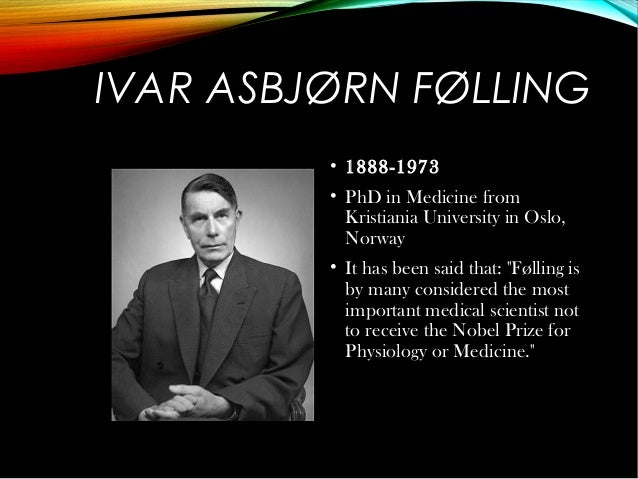Ivar Asbjørn Følling
Ivar Asbjørn Følling ( born August 23, 1888 in Kvam, today Steinkjer; † 24 January 1973) was a Norwegian chemist and physician.
Life
Childhood and youth
Følling was born as the youngest of seven children on a farm in central Norway. It was very early for him and his siblings, of course, to touch at work on the family homestead with. He attended the village school and was allowed after the ninth grade go to school in Trondheim, where he lived with his oldest sister. Here he completed the tenth to twelfth grade.
With the completion of high school he was diagnosed with tuberculosis and in the absence of other effective treatments he had to rest for a year without any agricultural work or studies. This year he was able to do a lot of thinking about what he should do with his life and decided not to be a farmer but scientist and physician. His father wanted it that way, although not initially permit, because the family was to poor to fund a study can and his labor was needed on the family farm. But Følling was very determined and negotiated with him that he could try to get that degree with teaching younger students to earn themselves and to come home to the farm in the summer to help with the work.
Study and academic career
So Følling studied after the completion of the single and newly established Norwegian Technical University in Trondheim Chemical Engineering. After graduating in 1916 expected his family that he if not, it took up residence in Trondheim on the family farm. Følling planned, however, to continue his studies at the University of Oslo and requested a small loan from his father, who granted it to him in the belief that it was a jump start for careers in the great capital. When he had to ask a year later for financial support, Følling confessed to the urging of his brother, that he taught at the University of Kristiania, at the Dental Faculty of Chemistry and part-time study medicine. Fortunately, the father admired his son studied and wished him all the best. Also taught after the completion of this study in 1922 and conducted research Følling further at the Dental Faculty. In the following years he traveled extensively, has held various positions as assistant physician and trained in England, Denmark and the USA, where he studied in 1928 with a grant from the Rockefeller Foundation to continue. In 1929 he was awarded the academic degree of Doctor. 1930 was followed by a second research trip to the U.S. in 1931 he married his wife, Guri, who accompanied him shortly after the wedding to another research grant to Vienna. In 1932 he was appointed professor of food science at the University of Oslo and in 1935 professor of physiology at the veterinary college. From 1953 until his retirement in 1958 he was a professor of biochemistry and medical director of the central laboratory at Rikshospitalet in Oslo.
Work
The name Føllings is mainly associated with the first discovery of a congenital metabolic disease, phenylketonuria. This disease is called in Norwegian language in his honor mostly Følling disease.
The parents of two children with mental retardation in Oslo had noticed a strange musty smell of the urine of both siblings. They learned that Følling research on metabolic diseases and occurred after several failed visits to the doctor in 1939 with the question up to him whether possibly a connection between this eye-catching smell and the disability of their children could be. Although Følling had never heard of such a context, he agreed to examine the urine. At the first examination of a urine sample of the older daughter, the current samples on protein, blood, inflammatory cells, and glucose were normal. When he replied in search of ketones an acidified urine sample with iron ( III ) chloride solution, this turned dark green, a reaction that he had never seen before. Obviously had to be present an unknown substance in the urine. Even the younger brother, he found the same striking reaction with ferric chloride. Now Følling began after the unknown substance to look for that he eventually identified as phenylpyruvic. Since he had not forgotten the original question of the parents, whether there was a connection with the spiritual development disorder, he examined in institutions for the care of the mentally handicapped in and around Oslo a total of 480 children and found eight of them more with the eye-catching Excretion, two other sibling pairs. In the same year he published in a Norwegian and a German magazine his findings and called the disorder first Imbecillitas phenylpyruvica, phenylpyruvic bullshit.










